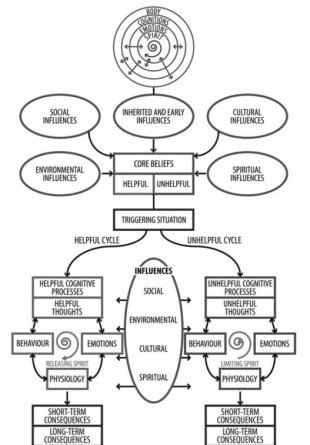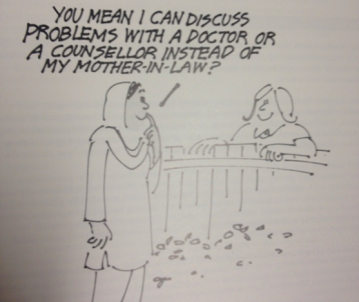
I feel like we’ve travelled back in time. Since the announcement that the UK was going to leave the EU, there has been a rise in racist attacks. Unfortunately, these attacks do not seem to be exclusive to the UK, but in the USA there have been multiple examples of men from black backgrounds being shot by white policemen. This has given rise to protests standing against discrimination see #blacklivesmatter. I say that we have travelled back in time, because similar protests demanding fair and equal treatment for black people were happening around two-three decades ago. In countries which are economically and technically advanced, it is frightening that people from black and ethnic minority backgrounds still do not have fair and equal treatment and that some people’s perceptions around difference are still infantile.
The media do a very good job at emphasising negative events causing more anxiety and fear. Hearing that the majority of England voted to leave the EU based on wanting to “get rid of immigrants” does elicit feelings of anxiety in me. I feel unsafe and feel like I need to go round holding up my passport in front of my face to defend that I am British, was born here and have no other country that I would consider my home. I feel safer in London, which is enriched with varied languages, faces, dress sense, cultures, social backgrounds, economic backgrounds and experiences. Whilst we all have differences, we need to acknowledge that despite these differences we have universal similarities that make us human. Pain, suffering, happiness, fear, shame, excitement, love are all concepts that we can all understand, that we can all connect with. We should not be fighting one another, but embracing in these similarities. Unfortunately our society is created in such a way that so many people are oppressed by authoritative systems and find power by projecting their suffering to other people and causing others to suffer.
I would however like to dedicate this post to some movements happening within clinical psychology around diversity, to illustrate that there are people in the UK who support and celebrate difference and who are working very hard to enable the needs of diverse communities to be met and heard.
Psychological therapy is misconceived as being for “white people”, this is problematic in that people from black and ethnic minority backgrounds are more likely to be prescribed medication, be admitted to mental health wards and not access services. Some mental health services are making efforts to ensure individual and group therapy sessions involve interpreters where possible and those who refer people to psychological services are aware that services do use interpreters and that all cultures and races have fair access to therapy. An additional problem is that psychological models used in psychological therapy are based largely on Western culture and concepts, whilst elements of these models will strike a chord with people from diverse backgrounds, there are many factors that have a large influence on wellbeing and psychology such as culture, religion and spirituality that will not be covered. Thus more work needs to be done to create ethnocentric psychological models.
Here are a few of those models (please note some models are not evidence-based yet and are proposals):
Hilary Garraway’s Adapted Cognitive Behavioural Therapy (CBT) Model
During a psychological assessment, the psychologist/therapist will likely ask questions that cover social factors, biological factors, environmental factors and cultural factors. However very rarely will a psychologist/therapist ask about religious or spiritual factors. If the questions are not asked, it is unlikely that the person in therapy will disclose these aspects of their lives. Even when they do, if the therapist/psychologist has little knowledge/awareness around these aspects they will not be discussed very well. Garraway’s holistic CBT model incorporates Spirituality, where unhelpful and helpful factors are discussed. Reflecting on my own experience as a British Indian, my spirituality has influenced my thoughts, feelings and behaviour in helpful and unhelpful ways. Praying in a Hindu temple is a helpful behaviour for me because I feel calm, safe and peaceful. It allows me to have time for myself where I can reflect on everything in my life I am thankful for and takes me away from the busyness of day to day life outside the walls of the temple. My spirituality has also caused some conflict for me. Working in a field that considers itself scientific has been difficult. In the Western world, there is the idea that science and spirituality or religion can not exist in tandem. This caused inner conflict in me as for me science and religion did exist in tandem but the society that I lived in did not accept this. This conflict may not have been completely apparent to me and may have been projected as symptoms of distress. It is helpful to have these discussions with a psychologist as treating symptoms of distress are a temporary fix, without acknowledging the conflict that has led to the symptoms of distress, a person is unlikely to fully recover. I like Garraway’s model as it really examines what is important, helpful and unhelpful at an individual level.

Figure above: Garraway’s holistic CBT model
A culturally adapted intervention for postnatal depression in British Asian women (ROSHNI2 trial; Masood and colleagues, 2015)
This randomly controlled trial (RCT) looked at culturally adapting a CBT model commonly and effectively used for treating postnatal depression. The intervention enabled better access to therapy for British Asian women. Some barriers to accessing therapy included childcare, access to transport and language. The intervention provided childcare, transport and facilitators of the group intervention were bilingual, speaking English and Urdu. The factors that elicit depression within the South Asian population is likely to have some differences to a white population. For example the women that took part in the therapy were from a Pakistani background. It is common within this background that women may only leave their houses if they are accompanied by their husband or another family member. This is likely to have psychological impact to the woman, in regard to self-esteem and confidence. Other factors may include social isolation, language barriers, unemployment. The therapy sessions looked at pressures and expectations of Pakistani women, examples of depression, understanding and managing self-esteem, envy within and across families, religion and spirituality, pressures of looking good. Many of the themes were targeted at looking at common issues women of a Pakistani background face. The intervention was effective in increasing well being.
Blackness Centred Compassion Therapy (in development) (Guilaine Kinouani)
This model proposed by Guilaine Kinouani adapts compassion therapy. It considers a person’s ethnic and ancestoral history along with the psychological impact of shame. Shame is an important psychological concept in many ethnic communities and is something that is not widely discussed in Eurocentric approaches. The shame experienced by many people from ethnic communities is usually wider than on an individual scale, for example as an Indian, my parents would explain that “bad” behaviour would bring shame to the family inflicted by the wider family community. The shame discussed by Guilaine, is one experienced by people from a black community in regard to feeling ashamed for being black in a white community. Again, the shame is a bi-product of not fitting in with the expectations of a larger community. The model incorporates acknowledgement of race-based shame in relation to a personal and historical context. Coping mechanisms to deal with this shame are also examined.
I would advise that you read more about the proposed model on Guilaine’s blog Race Reflections. The model is well explained connecting psychological theories and concepts with experiences of being black.

Psychology therapy sessions aim to create a safe space for people to be completely honest and disclose inner secrets, conflicts, desires that are rejected on a wider basis. However, if the therapist/psychologist is not willing to listen and acknowledge aspects of experience and identity that involve protective characteristics such as race, gender, sexual orientation, disability, etc. then they are only doing half the job. Talking about protective characteristics and people’s experiences in regard to them are silenced within society. Talking about discrimination makes people feel uncomfortable. If therapy reflects this, then it is not going to be effective for people who identify with diverse protective characteristics. The models discussed above are a good start for allowing people the space and opportunity to be heard and talk about issues that society has prevented people from talking about.